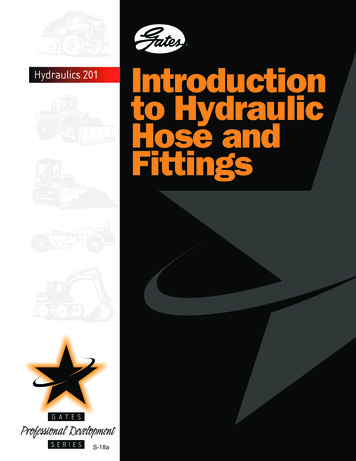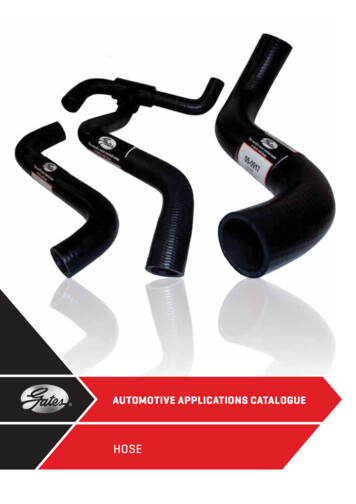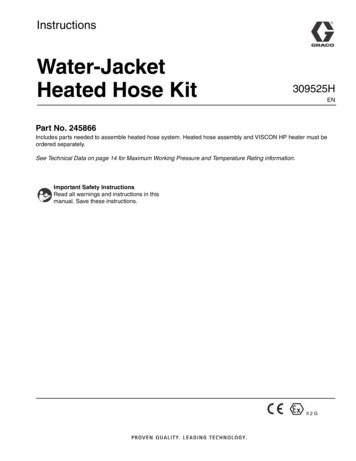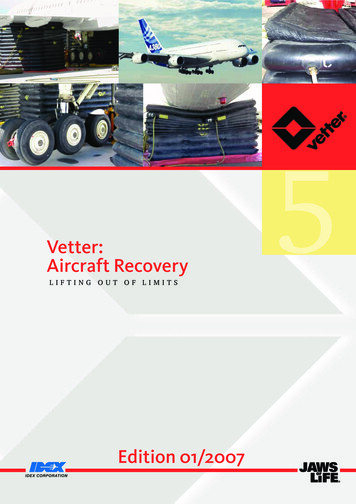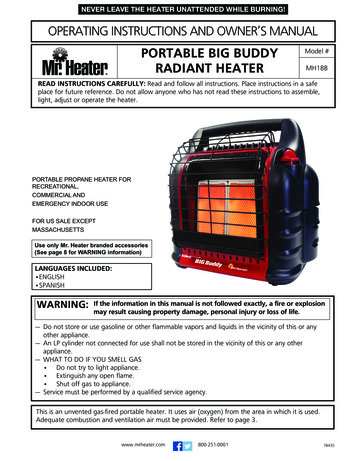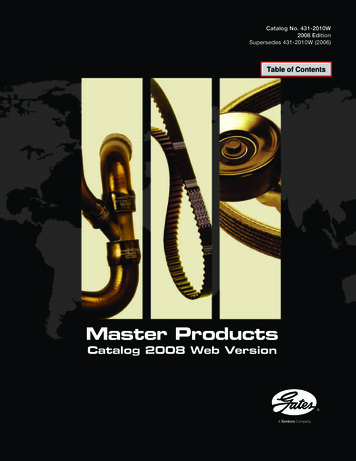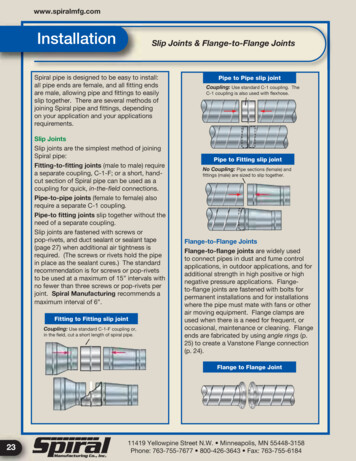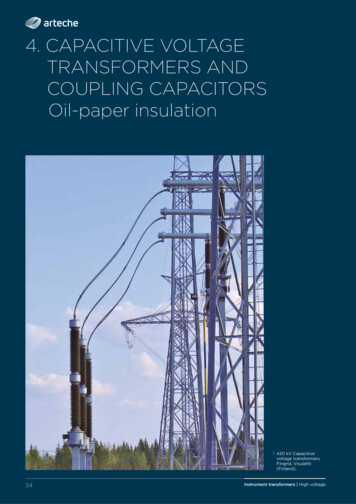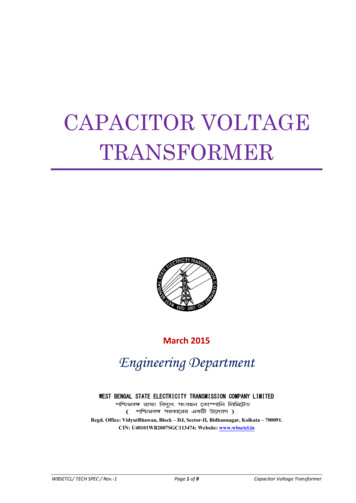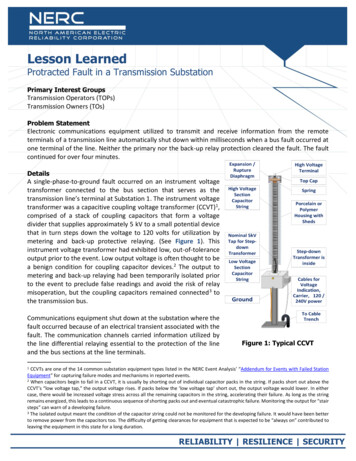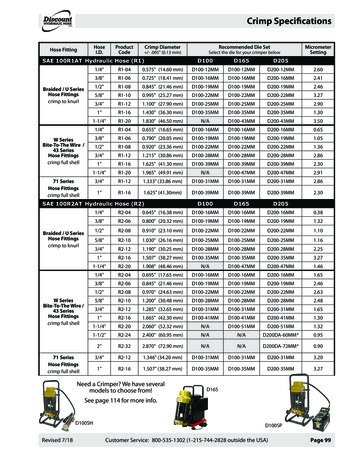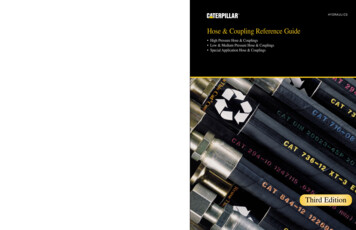
Transcription
HYDRAULICSHose & Coupling Reference Guide—3rd EditionHose & Coupling Reference Guide High Pressure Hose & Couplings Low & Medium Pressure Hose & Couplings Special Application Hose & CouplingsThird EditionPECP5030-02 1999 CaterpillarPrinted in U.S.A.
Table of ContentsSectionPageIntroduction.2Hose Selection.5Industry Standard Comparison .6SAE Comparison .13DIN Comparison .13JIS Comparison .14Working Pressure .15Fluid Compatibility .16Coupling Identification .18High Pressure .25XT-3 ES Hose (736) .26XT-3 Hose Reusable Couplings .27XT-3 Hose Permanent Couplings.40Caterpillar DIN Four-Wire Spiral Hose (1956).48Caterpillar (1956) Permanent Couplings .49XT-5 Hose (1036) .62XT-5 Hose Reusable Couplings .63XT-5 Hose Permanent Couplings.72XT-6 Hose (1136).76XT-6 Hose Reusable Couplings .77XT-6 Hose Permanent Couplings.80Low and Medium Pressure.83Caterpillar Hydraulic and Suction Hose (716, 294, 844) .84Caterpillar Hose Couplings (716, 294, 844) .87Special Application.115Caterpillar Thermoplastic Hose (1028) .116Caterpillar Hose Couplings (1028) .117Caterpillar Reduced O.D. Thermoplastic Hose (2760) .124Caterpillar Hose Couplings (2760) .125Caterpillar Engine & Air Brake Hose (556, 1130) .132Caterpillar Hose Couplings (556, 1130) .134Caterpillar Air Conditioning Hose (1543) .142Caterpillar Hose Couplings (1543) .143Caterpillar Specialty Hose .149Seals and Miscellaneous Products .153O-Ring Application Charts .154Seals .155Seal Kits.161Split Flanges & Hardware.165Hose Clamps .171Armor Guard .173Captive Flanges.177Adapters .181NPTF Adapters .182JIC Adapters .188ORFS Adapters.214Metric Adapters.239NPSM Adapters .249Miscellaneous Adapters.255Caps / Plugs .261Tooling .277Reference Material .311Part Number Index.315
IntroductionAs system pressures and other demands on today's equipment increase, so does the need forreliable hose and couplings. Why tolerate premature hose and coupling failures when we canhelp you avoid them with superior hose products and service?Caterpillar stands alone as the only equipment manufacturer who makes its own hose andcoupling products. This catalog includes information on Caterpillar low, medium and highpressure hose and coupling product lines. We have a full stock of replacement products forearthmoving and other applications. That means no more running from one source to anotherto find the parts you need.Caterpillar Hose Products Exceed Industry StandardsCat hose and couplings are designed to work together as a system for problem-freeperformance, no matter what brand of machine you operate. Testing performance for mostproducts exceeds SAE requirements. Most hoses meet the MSHA flame resistancerequirements as well.XT Hose and Couplings . DifferentiationCaterpillar's superior hose construction and testing differentiates it from other manufacturers.Caterpillar was the first to design and manufacture high pressure hydraulic hose knownthroughout the industry as XT hose. XT hose standards far exceed industry standards stilltoday. XT hose is impulse tested to one million cycles - twice the industry requirement - at133% of working pressure using both new and aged hose.The differentiation does not stop at the hose. Caterpillar offers reusable couplings for XT hoseto help keep your owning and operating costs at a minimum. Caterpillar reusable couplings forXT hose are the last coupling you should ever need.XT-3 ES HoseCaterpillar's XT-3 ES hose provides up to 20 times more abrasion resistance than the industry’sbest rubber-covered hose, due to an exclusive cover formulated and manufactured byCaterpillar. Cat XT-3 ES hose works at half of the SAE bend radius without sacrificing cold flexcapability.Caterpillar 1956 Hose and Couplings Meet Your Mixed Fleet Needs(1956 hose (DIN 20023 4SP) and coupling) The product line joins the extensive line of highpressure XT hose components that have set the industry standard for reliability and durabilityfor nearly 30 years.2
IntroductionCaterpillar Low and Medium Hose and CouplingsCaterpillar manufactures one wire braid (716), two wire braid (294) and hydraulic suction (844)hose and couplings. These too exceed SAE requirements for the best in reliable hose andcoupling performance. These hoses are impulse tested in both the unaged and aged condition,up to two and a half times the number of cycles required by SAE, to assure reliableperformance.Caterpillar 716 and 294 hose and couplings also meet DIN 20022 1SN and 20022 2SNstandards.Caterpillar Special Application Hose and CouplingsCaterpillar offers a complete line of thermoplastic, engine / air brake and air conditioning hoseand couplings, including a line of reduced outside diameter (O.D.) thermoplastic hose andcouplings (2760), used extensively in earthmoving equipment hydraulic pilot lines.More of Your Equipment Can Be Converted to Cat HoseWith the Cat hose and coupling product line, more systems can be converted to high quality Cathose and couplings. This is only a short rundown of industries which have found success intheir conversions to Cat Hose:MiningPulp and Plywood MillsLoggingManufacturing structionHydraulic System ServicesWhen you need hose repairs, we can provide fast, over-the-counter service by making hoseassemblies to your specifications while you wait. Better yet, call ahead and we can have themwaiting for you.If you prefer to make your own assemblies, we can help there, too. We will set you up with theproper tooling and training and even assist with stocking requirements.Whatever your hydraulic system needs, we have the resources to get your machines up andrunning quickly with the work done right the first time.When you need quality hose and couplings, it makes sense to use the bestavailable. You can trust Cat Hose and Couplings for all your needs!3
IntroductionBefore You Measure Hose and Stem Assemblies,Review This Information1.2.3.4.Determine what type of hose assembly is to be replaced.Measure the inside diameter of the hose.Measure the angle, actual head size, and length of the stem assemblies.Select the proper stem assembly from the part numbers pages.a. Locate inside diameters for your hose.b. Check the list of actual head sizes and lengths of stem assemblies.c. Locate the desired angle for your stem assembly.d. When all the dimensions agree, locate the part number.5. Add the cut-off factors for your stem assemblies.6. Subtract this total length from the overall length of the hose assembly.7. Cut bulk hose to length needed for hose assembly.8. Assemble the new hose assembly using sleeves, stems, and armor if needed.Coupling DimensionsA. Actual Head SizeB. Stem Assembly LengthC. Cut-Off FactorD. Drop LengthE. Degree of AngleF. Hose Inside DiameterHose Assembly MeasurementsFlange-type Assembly–Subtract thecut-off factors from the overall assemblylength to determine the length of bulkhose required.Thread-type Assembly–Subtract thecut-off factors and theassembled length of theadapter from the overallassembly length to determinethe bulk hose required.Assemblies are measuredto the centerline of the sealingsurface.Coupling Angleof OrientationThe angle of orientation between thestem assemblies is measured with thefar stem assembly verticallydownward and viewing theassembly from the near stemassembly end.4
Hose SelectionFlow Capacity NomographFlow Capacities of Caterpillar Hoseat Recommended Flow VelocitiesThe chart below is designed and provided as an aid in thedetermination of the correct hose size.1. determine flow and velocity of system;2. find them on indexes below;3. connect line with straight edge to determine correct hose size.AREA (IN2) FLOW (GPM) X .3208VELOCITY (FT/SEC)RecommendedMaximum Velocity forPressure LinesVelocity, Feet Per SecondInside Diameter of Hose, InchesFlow, Gallons per Minute (gpm)RecommendedMaximum Velocityfor Suction Lines5
Industry Standard ComparisonSAE 100R1AT vs Cat One-Wire Braid Hose (716)IMPULSE TESTINGWORKING PRESSURE*HOSEINNERINNER MAX. WORK. PRESS. MAX. WORK. PRESS. MAX. WORK. PRESS.DASH DIAMETER ENUMBEROFCYCLES100R1-3 to -16 125% of W.P. -20 to -32 100% of W.P. 212 F ( 100 C) 150,000 212 F ( 100 C) 150,000716All Sizes100% of W.P. 275 F ( 135 C) 250,000#TEMPERATURE CAPABILITIES100R1:716:-40 F to 212 F (-40 C to 100 C)-40 F to 275 F (-40 C to 135 C)*Minimum burst pressure will always be 4X the maximum working pressure for both Caterpillar andSAE standard hose.#For this test, 716 hose is aged at 300 F ( 150 C) for 200 hours and -25 F (-32 C) for 18 hours priorto impulse testing. In addition, in the middle and at the end of each impulse test, no leaks are allowedafter the oil cools to room temperature and the test machine is restarted. SAE does not require agedsamples or room temperature leak checks. W.P. Working PressureDIN 20022 1SN vs Cat One-Wire Braid Hose (716)WORKING PRESSURE*DINDNSIZEIMPULSE TESTINGINNERINNER MAX. WORK. PRESS. MAX. WORK. PRESS.DIAMETER DIAMETER(psi)(BAR)(in)(mm)20022 1SN 71620022 1SN 716MAX. WORK. PRESS.(kPa)20022 580580404040004000*Minimum burst pressure will always be 4X the maximum working pressure for both Caterpillar andSAE standard hose.#For this test, 716 hose was tested against the DIN 20022 1SN specifications for use in DINapplications. W.P. Working Pressure6TESTPRESSUREDIN 20022 1SN5 to 2532 to 50TESTTEMPERATURENUMBEROFCYCLES125% of W.P. 100% of W.P. 212 F ( 100 C) 150,000 212 F ( 100 C) 150,000125% of W.P.100% of W.P. 212 F ( 100 C) 150,000# 212 F ( 100 C) 150,000#7165 to 2532 to 50TEMPERATURE CAPABILITIESDIN 20022 1SN: -40 F to 212 F (-40 C to 100 C)716:-40 F to 212 F (-40 C to 100 C)
Industry Standard ComparisonSAE 100R2AT" vs Cat Two-Wire Braid Hose (294)IMPULSE TESTINGWORKING PRESSURE*HOSEINNERINNER MAX. WORK. PRESS. MAX. WORK. PRESS.DASH DIAMETER DIAMETER(psi)(BAR)SIZE(in)(mm)100R2294100R2294MAX. WORK. LES100R2All Sizes133% of W.P. 212 F ( 100 C) 200,000133% of W.P. 212 F ( 100 C) 500,000#294All SizesTEMPERATURE CAPABILITIES100R2:294:-40 F to 212 F (-40 C to 100 C)-40 F to 212 F (-40 C to 100 C)*Minimum burst pressure will always be 4X the maximum working pressure for both Caterpillar andSAE standard hose.#For this test, 294 hose is aged at 225 F ( 107 C) for 150 hours and -25 F (-32 C) for 18 hours priorto impulse testing. In addition, in the middle and at the end of each impulse test, no leaks are allowedafter the oil cools to room temperature and the test machine is restarted. SAE does not require agedsamples or room temperature leak checks. W.P. Working Pressure" AT designates the thinner cover used on no-skive hose.DIN 20022 2SN vs Cat Two-Wire Braid Hose (294)IMPULSE TESTINGWORKING PRESSURE*DINDNSIZEINNERINNER MAX. WORK. PRESS. MAX. WORK. PRESS.DIAMETER DIAMETER(psi)(BAR)(in)(mm)20022 2SN 29420022 2SN294MAX. WORK. PRESS.(kPa)20022 REDIN 20022 2SNAll SizesTESTTEMPERATURENUMBEROFCYCLES133% of W.P. 212 F ( 100 C) 200,000133% of W.P. 212 F ( 100 C) 200,000#294All SizesTEMPERATURE CAPABILITIESDIN 20022 2SN: -40 F to 212 F (-40 C to 100 C)294:-40 F to 212 F (-40 C to 100 C)*Minimum burst pressure will always be 4X the maximum working pressure for both Caterpillar andSAE standard hose.#For this test, 294 hose was tested against the DIN 20022 2SN specifications for use in DINapplications. W.P. Working Pressure7
Industry Standard ComparisonSAE 100R4 vs Cat Hydraulic Suction Hose (844)WORKING PRESSURE*IMPULSE TESTINGHOSEINNERINNER MAX. WORK. PRESS. MAX. WORK. PRESS. MAX. WORK. PRESS.DASH DIAMETER URENUMBEROFCYCLES100R4All Sizes NO IMPULSE TESTING PERFORMED844All Sizes NO IMPULSE TESTING PERFORMEDTEMPERATURE CAPABILITIES100R4:844:-40 F to 212 F-40 F to 275 F(-40 C to 100 C)(-40 C to 135 C)*Minimum burst pressure will always be 4X the maximum working pressure for both Caterpillar andSAE standard hose.SAE 100R5 vs Cat One-Wire Braid Hose - Fabric Covered (556)WORKING PRESSURE*IMPULSE TESTINGHOSEINNERINNER MAX. WORK. PRESS. MAX. WORK. PRESS. MAX. WORK. PRESS.DASH DIAMETER *Minimum burst pressure will always be 4X the maximum working pressure for both Caterpillar andSAE standard hose.#For this test, 556 hose is aged at 275 F ( 135 C) for 200 hours and -25 F (-32 C) for 18 hours priorto impulse testing. In addition, in the middle and at the end of each impulse test, no leaks are allowedafter the oil cools to room temperature and the test machine is restarted. SAE does not require agedsamples or room temperature leak checks. W.P. Working 100R5-4 to -16 125% of W.P. -20 to -32 100% of W.P. 212 F ( 100 C) 150,000 212 F ( 100 C) 100,000556-4 to -16 125% of W.P.-20 to -32 100% of W.P. 250 F ( 120 C) 150,000# 250 F ( 120 C) 100,000#TEMPERATURE CAPABILITIES100R5:556:-40 F to 212 F (-40 C to 100 C)-40 F to 250 F (-40 C to 121 C)
Industry Standard ComparisonSAE 100R7 vs Cat Thermoplastic Hose (1028)WORKING PRESSURE*HOSEINNERINNER MAX. WORK. PRESS. MAX. WORK. PRESS. MAX. WORK. PRESS.DASH DIAMETER —-322.00050.8——————IMPULSE 0R7All Sizes 125% of W.P. 200 F ( 93 C) 150,0001028All Sizes 100% of W.P.OR133% of W.P. 200 F ( 93 C) 1,000,000 200 F ( 93 C) 150,000#TEMPERATURE CAPABILITIES100R7:1028:-40 F to 200 F (-40 C to 93 C)-70 F to 200 F (-56 C to 93 C)*Minimum burst pressure will always be 4X the maximum working pressure for both Caterpillar andSAE standard hose.#For this test, 1028 hose is aged at 200 F ( 93 C) for 150 hours and -25 F (-32 C) for 18 hours priorto impulse testing. In addition, in the middle and at the end of each impulse test, no leaks are allowedafter the oil cools to room temperature and the test machine is restarted. SAE does not require agedsamples or room temperature leak checks. W.P. Working PressureSAE 100R12 vs XT-3 ES Hose (736)WORKING PRESSURE*HOSEINNERINNER MAX. WORK. PRESS.DASH DIAMETER DIAMETER(psi)SIZE(in)(mm)100R12XT-3MAX. WORK. PRESS.(BAR)100R12XT-3MAX. WORK. 00IMPULSE 0R12All Sizes133% of W.P. 250 F ( 121 C) 500,000XT-3 ESAll Sizes133% of W.P. 250 F ( 121 C) 1,000,000#TEMPERATURE CAPABILITIES100R12:XT-3 ES:-40 F to 250 F (-40 C to 121 C)-40 F to 250 F (-40 C to 121 C)BEND RADIUS100R12: SAEXT-3 ES: 1/2 SAE*Minimum burst pressure will always be 4X the maximum working pressure for both Caterpillar and SAEstandard hose.#For this test, XT-3 ES hose is aged at 250 F ( 121 C) for 150 hours and -25 F (-32 C) for 18 hoursprior to impulse testing. In addition, in the middle and at the end of each impulse test, no leaks areallowed after the oil cools to room temperature and the test machine is restarted. SAE does notrequire aged samples or room temperature leak checks. W.P. Working Pressure9
Industry Standard ComparisonDIN 20023 4SP vs Cat DIN Four-Wire Spiral Hose (1956)WORKING PRESSURE*HOSEINNERINNERDASH DIAMETER DIAMETERSIZE(in)(mm)IMPULSE TESTINGMAX. WORK. PRESS. MAX. WORK. PRESS. MAX. WORK. PRESS.(psi)(BAR)(kPa)20023 4SP 195620023 4SP195620023 4SP 060406028028028,000 239330452683239321018516521018516521,000 21,00018,500 18,50016,500 16,500TESTPRESSUREDIN 20023 4SPAll Sizes1956All SizesTESTTEMPERATURENUMBEROFCYCLES133% of W.P. 212 F ( 100 C) 400,000133% of W.P. 212 F ( 100 C) 400,000TEMPERATURE CAPABILITIESDIN 20023 4SP: -40 F to 212 F (-40 C to 100 C)1956:-40 F to 212 F (-40 C to 100 C)*Minimum burst pressure will always be 4X the maximum working pressure. W.P. Working PressureSAE 100R13 vs XT-5 Hose (1036)IMPULSE TESTINGWORKING PRESSURE*HOSEINNERINNER MAX. WORK. PRESS. MAX. WORK. PRESS. MAX. WORK. PRESS.DASH DIAMETER —5000—345—35,000*Minimum burst pressure will always be 4X the maximum working pressure for both Caterpillar andSAE standard hose.#For this test, XT-5 hose is aged at 250 F ( 121 C) for 150 hours and -25 F (-32 C) for 18 hoursprior to impulse testing. In addition, in the middle and at the end of each impulse test, no leaks areallowed after the oil cools to room temperature and the test machine is restarted. SAE does notrequire aged samples or room temperature leak checks. W.P. Working S100R13All Sizes120% of W.P. 250 F ( 121 C) 500,000XT-5All Sizes120% of W.P. 250 F ( 121 C) 1,000,000#TEMPERATURE CAPABILITIES100R13:XT-5:-40 F to 250 F (-40 C to 121 C)-40 F to 250 F (-40 C to 121 C)
Industry Standard ComparisonSAE J1402 vs Cat Engine and Air Brake Hose (1130)IMPULSE TESTINGWORKING PRESSURE*HOSEINNERINNER MAX. WORK. PRESS. MAX. WORK. PRESS. MAX. WORK. PRESS.DASH DIAMETER RENUMBEROFCYCLESJ1402All SizesNO IMPULSE TESTING PERFORMED1130All SizesNO IMPULSE TESTING PERFORMED#TEMPERATURE CAPABILITIESJ1402:1130:-40 F to 200 F (-40 C to 93 C)-40 F to 275 F (-40 C to 135 C)*Minimum burst pressure will always be 4X the maximum working pressure for both Caterpillar andSAE standard hose.#Cat 1130 hose passes a severe hot oil circulation test that exposes the hose liner to 300 F oil for750 hours with no cracking or leakage permitted; SAE J1402 requires no such test.SAE J51 Type D vs Cat Air Conditioning Hose (1543)IMPULSE TESTINGWORKING PRESSURE*HOSEINNERINNER MAX. WORK. PRESS.DASH DIAMETER 6250.8751.1251.375-321.813MAX. WORK. PRESS.(BAR)J51-D1543MAX. WORK. MBEROFCYCLESJ51-DAll SizesNO IMPULSE TESTING PERFORMED1543All SizesNO IMPULSE TESTING PERFORMED#TEMPERATURE CAPABILITIESJ51-D:1543:-22 F to 248 F (-30 C to 120 C)-22 F to 257 F (-30 C to 125 C)*Minimum burst pressure will always be 4X the maximum working pressure for both Caterpillar andSAE standard hose.#1543 meets SAE standards for type-D hose concerning Freon permeation and moisture ingression.1543 has a maximum Freon permeation of 5lbs/ft2 per year at 300 F ( 150 C). 1543 has a maximummoisture ingression of 16 g/100 in2 per year. This hose can be used with SAE J2064 R134Arefrigerant. Maximum permeation rate is 2 lbs/ft2 per year at 176 F ( 80 C).11
Industry Standard ComparisonSAE 100R15 vs. XT-6 Hose (1136)IMPULSE TESTINGWORKING PRESSURE*HOSEINNERINNER MAX. WORK. PRESS. MAX. WORK. PRESS. MAX. WORK. PRESSDASH DIAMETER ,000 42,00042,000 ——414414414414—414414414———42,000 42,00042,000 42,00042,000 mum burst pressure will always be 4X the maximum working pressure for Caterpillar hose.#For this test, XT-6 hose is aged at 250 F ( 121 C) for 150 hours and -25 F (-32 C) for 18 hoursprior to impulse testing. In addition, in the middle and at the end of each impulse test, no leaks areallowed after the oil cools to room temperature and the test machine is restarted. SAE does notrequire aged samples or room temperature leak checks. W.P. Working S100R15All Sizes120% of W.P. 250 F ( 121 C) 500,000120% of W.P. 250 F ( 121 C) 1,000,000#XT-6All SizesTEMPERATURE CAPABILITIES100R15:XT-6:-40 F to 250 F (-40 C to 121 C)-40 F to 250 F (-40 C to 121 C)
SAE Comparison / DIN ComparisonRecommended Caterpillar Hose Replacementsfor SAE Specification HosesCATERPILLAR HOSE REPLACEMENTS for the indicated dash 12-16-20-24-32100R1100R2100R3100R4100R51 wire braid2 wire braid2 fiber braidHelical wire1 wire **100R6100R7100R8100R9100R101 fiber braidThermoplastic fiber braidThermoplastic fiber braid4 spiral wire4 spiral R126 spiral wire4 spiral -5XT-3XT-5XT-3100R13100R144 or 6 spiral wireTeflon 0R156 spiral wire******XT-6XT-6**XT-6XT-6XT-6****MAXIMUM WORKING PRESSURE (bar/psi) for the indicated DN size/dash size6810121620253240-4-5-6-8-10-12-16-20-2450-32* No SAE specification in this size** No Caterpillar replacement hose availableDIN 20021, 20022, and 20023 Specifications:Maximum Working Pressure (bar/psi)DINSPECIFICATIONHOSECONSTRUCTION20021 1TE1 fiber braid20021 2TE2 fiber braid20021 3TE2 fiber braid20022 1ST, 1SN1 wire braid20022 2ST, 2SN2 wire braid20023 4SP4 spiral wire20023 4SH4 or 6spiral 653 5806350914 725125901813 1305210 1853045 2060903805510325 2904713 42052503625* No DIN specification in this sizeRecommended Caterpillar Hose Replacementsfor DIN Specification ATERPILLAR HOSE REPLACEMENTS for the indicated DN size/dash size810121620253240-5-6-8-10-12-16-20-2450-3220021 1TE20021 2TE20021 3TE1 fiber braid2 fiber braid2 fiber 716716716716*716716*716716**716**XT-3**XT-320022 1ST, 1SN20022 2ST, 2SN20023 4SP1 wire braid2 wire braid4 spiral 19564 or 6 spiral wire******XT-6XT-6XT-5XT-5XT-520023 4SH* No DIN specification in this size** No Caterpillar replacement hose available13
JIS ComparisonJIS K6349 Specifications:Hose AXIMUM WORKINGPRESSUREN
Caterpillar Low and Medium Hose and Couplings Caterpillar manufactures one wire braid (716), two wire braid (294) and hydraulic suction (844) hose and couplings. These too exceed SAE requirements for the best in reliable hose and
